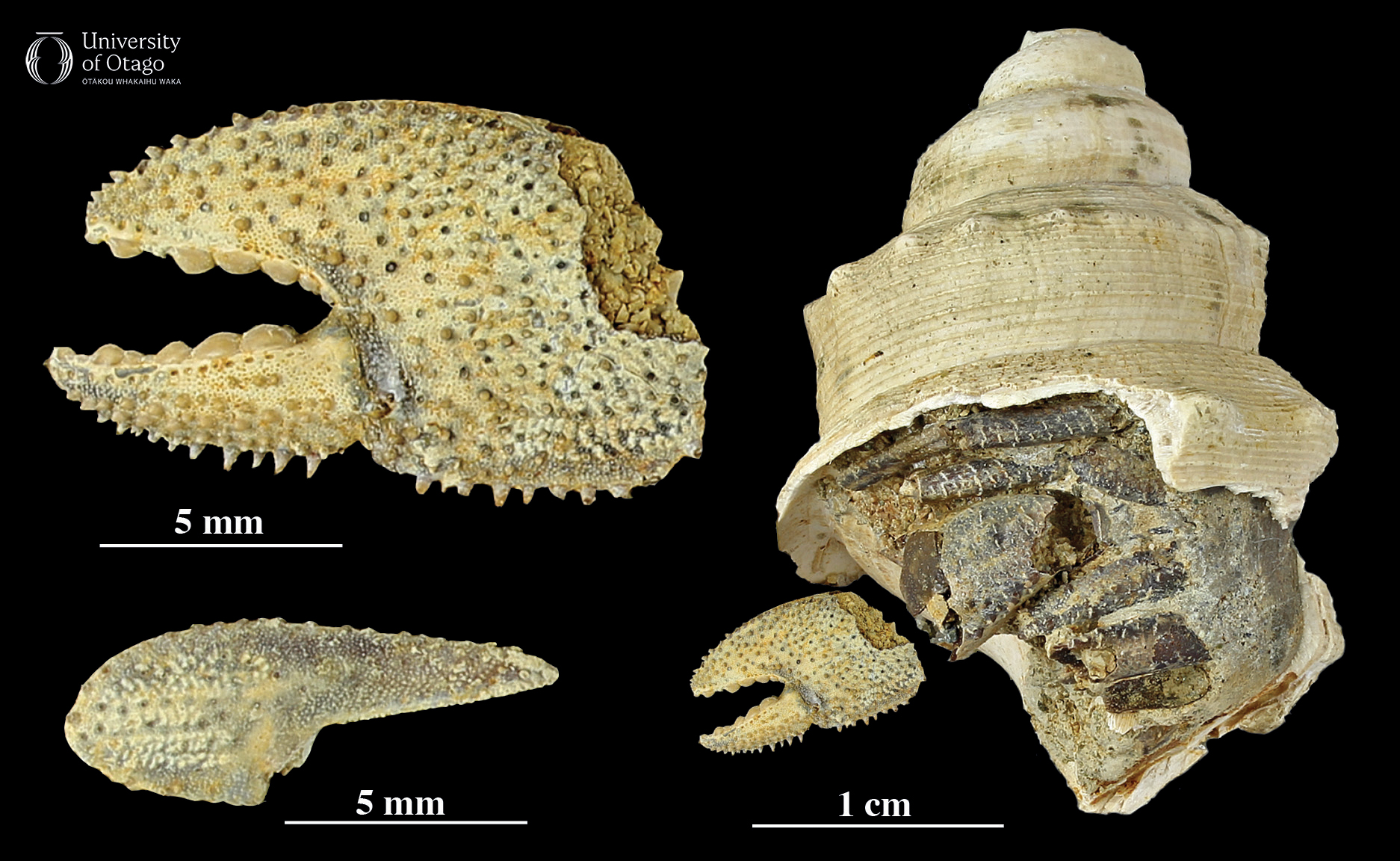51 Hermit crab inside its gastropod home
Arthropoda, Decapoda: Diacanthurus clifdenensis
Crab fossils are quite common in Aotearoa New Zealand, often preserved within calcareous concretions. Examples of the large, extinct species of stone crab Tumidocarcinus are frequent discoveries at various fossil sites around New Zealand.

Ancient hermit crab Diacanthurus clifdenensis (OU 11797) discovered in its last gastropod home. Image credit: JH Robinson. |
But one fossil crab in the Geology collections was a serendipitous, rare and exciting discovery – an entire, beautifully preserved hermit crab still hiding inside its gastropod home.
Found by Fiona Hyden in the Calamity Point Sandstone near Clifden, Western Southland during her PhD research on the limestones of the Southland region it was formally described as a new species of Pagurus (since moved to a new genus, Diacanthurus). The right cheliped of the fossil crab is larger than the left, and both are covered with large, cone-shaped tubercles all over the dorsal surface. There are conspicuous teeth along the opposable faces of the right chela.
Such hermit crabs belonging to the family Paguridae are a specialised group of decapod crustaceans that are mostly found in shallow-water, often rocky-shore, environments. Because their bodies are soft, they avoid predators by occupying the empty shells of gastropod molluscs, moving from smaller to larger shells (house-hunting) as they grow and moult. Crabs obviously need to have a reliable supply of suitable dwellings and at Calamity Point in the Early Miocene, there was a diverse fauna of around 90 species of gastropods, although not all would be suitable second homes for crabs.
The host shell for the hermit crab is Struthiolaria subspinosa, a turreted gastropod whose living relations, known as ostrich foot shells, are common inhabitants of sandy shores around New Zealand today. Similarly, the close living relative of Dicanthurus, D. spinulimanus, is common on muddy sand substrates around New Zealand at depths of 20 to 120 metres.
One reason why hermit crabs are rarely found as fossils is that they vacate their homes before death and usually only the heavily calcified chelipeds (claws) survive. Few such examples have been described from anywhere in the world and even fewer are well-enough preserved to be given a formal name.
—Written by Daphne E Lee
| Specimen number: OU 11797 | Age: Approximately 17 million years ago (early Miocene, Altonian stage) |
| Locality: Clifden, western Southland | Rock Formation: Calamity Point Sandstone, Nga Pari Formation |
| Collected by: F Hyden | |
| Citation: Hyden FM, Forest J. 1980. An in situ hermit crab from the Early Miocene of southern New Zealand. Palaeontology 23:471–474. | |
Evidence of life from a past geological age. Remains like bones, shells or wood, or an impression like a footprint, or some other evidence of life, from something that was alive more than 11,700 years ago.
Composed of calcium carbonate.
Sedimentary rock cemented into a solid structure through the gradual precipitation of minerals into the pore spaces between sedimentary grains.
Hyden FM. 1979. Mid-Tertiary temperate shelf bioclastic limestones, Southland, New Zealand. Unpublished PhD thesis, University of Otago.
http://download.otagogeology.org.nz/temp/Abstracts/1979Hyden_FM.pdf
Pincer-like claws at the anterior limbs of an arthropod, like a crab or lobster. Used for defence and to gather food.
The process of shedding an exoskeleton in order to grow. Also known as ecdysis.
23.03 million to 15.97 million years ago. The Early Miocene is a sub-epoch that spans the international Aquitanian and Burdigalian stages.

